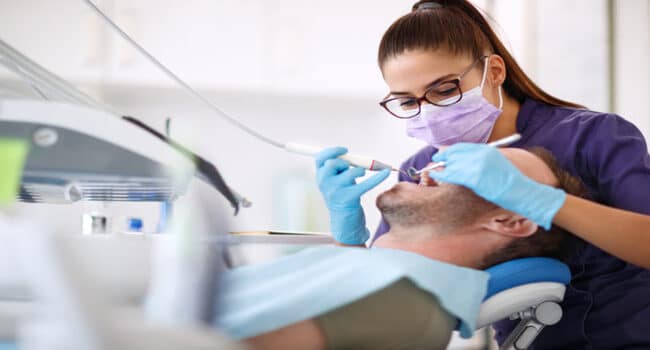Telehealth: Is it a Game-Changer?
Telehealth has emerged as a game-changer in various branches of medicine, including dentistry. Let us delves into the impact of telehealth on dental care, thus exploring its pros and cons with a blend of insightful analysis.
Navigating the Digital Dental Landscape
Telehealth, once a futuristic concept, has become a reality in the realm of dental care. With the rise of virtual consultations, teledentistry platforms, and remote monitoring technologies, patients and practitioners alike are navigating a new era of digital dentistry. Let’s take a closer look at the pros and cons of this digital revolution.
The Pros: Smile-Worthy Benefits of Telehealth in Dentistry
- Enhanced Accessibility: Telehealth breaks down barriers to dental care, particularly for individuals in remote or underserved areas. Patients can access consultations, follow-ups, and even preventive education from the comfort of their homes, no dental office waiting room required.
- Convenience, Thy Name is Telehealth: Say goodbye to long commutes and time-consuming appointments. Telehealth allows patients to schedule virtual visits at their convenience, fitting dental care seamlessly into their busy lives. No need to sacrifice that lunch break for a dental check-up; you can do it from your kitchen table.
- Empowering Patient Education: Telehealth platforms offer a wealth of educational resources, empowering patients to take proactive control of their oral health. From instructional videos on proper brushing techniques to interactive modules on dental hygiene, patients can become savvy smile advocates with just a few clicks.
- Time is of the Essence: For busy dental practices, telehealth can help streamline workflows and optimize efficiency. Dentists can conduct virtual triage assessments, screen patients for urgent concerns, and prioritize appointments, accordingly, saving time for both patients and practitioners.
The Cons: Navigating the Dental Digital Divide
- Hands-On Healing: While telehealth offers many benefits, it can’t replace the hands-on care provided during in-person dental visits. Some procedures, such as cleanings, fillings, tooth extractions, and orthodontic adjustments, require physical intervention that telehealth simply can’t replicate.
- Technical Troubles: Ah, the joys of technology. From glitchy video calls to unreliable internet connections, telehealth is not without its technical challenges. Patients and practitioners may encounter difficulties navigating telehealth platforms, leading to frustration and communication hiccups.
- The Personal Touch: Dentistry is as much about building rapport as it is about fixing teeth. Telehealth, while convenient, lacks the personal touch of face-to-face interactions. Patients may miss the opportunity for in-person conversations, reassuring smiles, and that comforting dental chair banter.
- Privacy Predicaments: In an age of increasing cybersecurity concerns, privacy is paramount in telehealth. Patients may have reservations about sharing sensitive medical information over digital channels, raising questions about data security and confidentiality.
Navigating the Telehealth Terrain: Finding Balance and Innovation
Telehealth holds immense promise for revolutionizing dental care, offering enhanced accessibility, convenience, and patient empowerment. However, it’s essential to navigate the digital terrain with a critical eye, acknowledging the limitations and challenges that come with the territory. By finding a balance between virtual and in-person care, embracing technological innovation, and prioritizing patient-centered approaches, the future of telehealth in dentistry looks bright—and full of smiles.
Embracing AI for Smarter Smiles
As we peer into the crystal ball of dental care, the future of telehealth holds exciting possibilities, particularly with the integration of artificial intelligence (AI). Here’s a glimpse into what the future may hold.
AI-Powered Diagnostics
Imagine a world where AI algorithms analyze dental images and patient data to provide rapid and accurate diagnostics. From detecting cavities and gum disease to identifying potential oral cancer risks, AI-powered diagnostics could revolutionize early detection and intervention, saving lives and preserving smiles.
Virtual Treatment Planning
AI algorithms could assist dentists in developing personalized treatment plans tailored to each patient’s unique needs and preferences. By analyzing patient data, including dental records, medical history, and genetic predispositions, AI can recommend the most effective and efficient treatment options, optimizing outcomes and patient satisfaction.
Remote Monitoring and Intervention
With the rise of wearable devices and IoT (Internet of Things) technology, AI-powered systems could enable remote monitoring of patients’ oral health in real-time. From tracking brushing habits and detecting signs of bruxism to monitoring orthodontic progress, AI-driven remote monitoring could empower patients to take proactive control of their oral health while providing dentists with valuable insights for intervention.
Predictive Analytics for Preventive Care
By analyzing vast amounts of data from patient populations, AI algorithms can identify patterns and trends that predict future oral health risks and outcomes. Armed with this predictive analytics, dentists can develop targeted preventive care strategies, such as personalized oral hygiene plans and lifestyle interventions, to mitigate risks and promote long-term oral wellness.
Teleconsultations with Virtual Assistants
AI-powered virtual assistants could facilitate teleconsultations between dentists and patients, streamlining communication and enhancing the patient experience. From scheduling appointments and answering FAQs to providing personalized oral health education, virtual assistants can serve as invaluable resources for both patients and practitioners, freeing up time for more meaningful interactions.
Ethical Considerations and Human Oversight
While the potential of AI in dental telehealth is vast, it’s essential to proceed with caution and ethical consideration. Human oversight and intervention are crucial to ensure the ethical use of AI in dental care, safeguarding patient privacy, autonomy, and informed consent. As we embrace AI-driven innovations, let’s remember that the ultimate goal is not just smarter smiles but healthier, happier patients.
